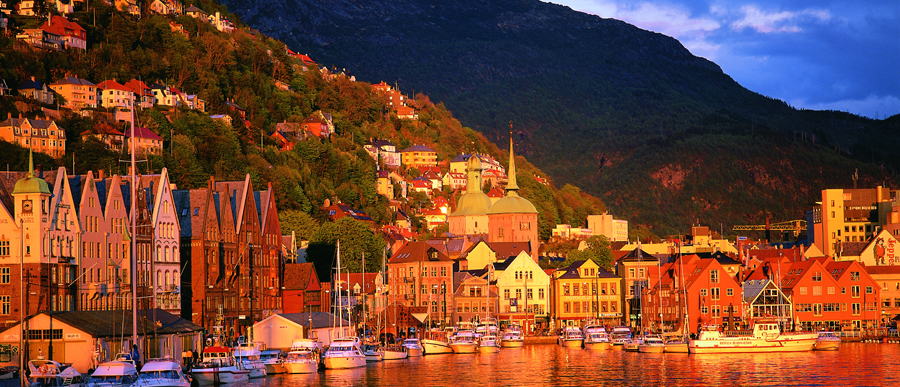
Known as the City of Seven Mountains (no prizes for guessing why), Bergen, on the west coast of Norway, has managed to retain an old-world charm and continues to enchant visitors with its rich history to this day. Bergen is also renowned for its close connection to some of the most beautiful natural sights in Norway, with its surrounds of mountains, fjords, and proximity to the ocean. On summer days, the temperature of the sea can be surprisingly warm due to the protection of the surrounding islands, making it an inviting location to take a dip. The city gets a lot of rain throughout the year, but this is something the locals have embraced; you’ll even see rainy scenes on postcards of the area!
Gateway to the Fjords
Bergen a city of many titles; it is also known as ‘The Gateway to the Fjords’. Sognefjord is located towards the north of the city, and Hardangerfjord to the south, with easy access to other notable destinations. National Geographic voted the Norwegian fjords as the world’s most unspoiled tourist destination; big claims only exceeded by the sheer size of the steep cliffs and deep ravines carved by prehistoric glaciers. Staying in Bergen means that you are ideally located to head out and explore the natural landscape of the area, and there are loads of tours to choose from when you’re planning your trip.
Truly experience the beauty of these natural behemoths on a boat trip along the rivers. Including a cruise along one of the narrowest fjords, Nærøyfjord, ‘Norway in a Nutshell’ begins in Bergen, and is probably the most famous of the fjord trips. It also includes a journey on the highest altitude railway in Northern Europe through wild mountainous terrain. Overall, the trip takes around nine hours.
If you’re short on time, ‘Fjord Cruise with the White Lady’ is another popular option which leaves from Bergen. It takes you on a vintage cruiseliner along the Osterfjord (just north of Bergen), with plenty of time to sit back and relax while the stunning mountains and waterfalls drift past.
Mountains and Surrounds
Mount Ulriken is the highest of the mountains around Bergen, with an altitude of 643 metres above sea level. There is an aerial tramway, Ulriksbanen, which connects the mountain to the city, and makes for some pretty incredible views on the way up – if you can bear to look down! At the top there’s a restaurant, and telescopes from which you can take in the surroundings.
The easiest of the seven mountains to navigate is centrally located Mount Floien. You have the option of hiking to the top or taking the Floien Funicular (cable car) from the city centre. From the top there are stunning views over the whole of Bergen, and the descent is an easy stroll down, leading you to the middle of the bustling Bergen Fish Market.
Possibly the best way to really experience the Norwegian landscape is to get out there and get active. There are loads of options to hike, climb or abseil on Mount Ulriken, as well as various cycling paths ranging from the relatively flat and peaceful to more challenging routes. For other adventurous activities around Bergen, you could try your hand at sea kayaking in the relatively calm waters of the surrounding islands. If you prefer to be on the banks rather than in the water, there are options for both fresh and salt-water fishing around the Bergen area, as well as opportunities to try deep-sea fishing. In winter, there are opportunities for both cross country and downhill skiing nearby.
Bryggen
At the heart of Bergen is the harbour, with its rows of cheerfully colourful wooden buildings that are one of Bergen’s most famous sights. Bryggen has been a hub of commerce and trade since the 12th Century. The buildings currently standing on the old wharf have been rebuilt many times following devastating fires, the most recent being in 1955, but each time the area was rebuilt, it was done based on the patterns and traditional building methods of the original structures. The buildings that remain today represent a relic of the wooden urban structure that once would have been common across Northern Europe. The appearance of Bryggen today dates back to the rebuilding after a fire in 1702, and the area is now listed as a UNESCO World Heritage Site.
Today, Bryggen is one of Bergen’s most popular tourist attractions, but it still remains as a working area of the town rather than a static museum, with restaurants, artist’s workshops, boutique shops and offices. The original compact medieval structure of the area has been preserved, with long, narrow rows of buildings facing the harbour, separated with wooden passages.
Great travel articles as well as deals, all sent directly to your inbox. Sign up today!
